- Home
- Sustainability
- Environment
- Responding to Climate Change
- Greenhouse Gas Emissions from Business Activities
Greenhouse Gas Emissions from Business Activities
Greenhouse Gas Emissions per Scope Based on the GHG Protocol
The Sumitomo Forestry Group calculates the volume of its GHG emissions according to scope,* based on the GHG Protocol, a set of widely used international accounting tools for quantifying GHG emissions.
In light of the increasing demand for renewable energy in recent years, the Sumitomo Forestry Group entered the wood biomass power generation business in 2011. The Mombetsu Biomass Power Plant, a consolidated subsidiary, uses coal as a supplementary fuel to ensure smooth operations and reduce maintenance burdens. As a result, since its commercial operations began in fiscal 2016, the Group’s Scope 1 and 2 emissions significantly increased. However, by reducing coal usage and introducing renewable energy at overseas manufacturing facilities, the Group’s Scope 1 and 2 emissions for fiscal 2024 decreased by 23.4% compared to fiscal 2023. When looking by business, our plants in Japan and the power generation business make up 31.3% while our plants overseas compose 39.2%.
We began calculating Scope 3 in fiscal 2013. We understand from the analysis that the impact of category 11, "Emissions during occupancy of sold detached houses" is particularly significant, and we are working to reduce CO2 emissions during occupancy by promoting ZEH (Net Zero Energy House) in our housing business. In addition, the scope of calculation for Scope 3 was expanded from fiscal 2022. After estimating approximately 100% coverage for the Sumitomo Forestry Group's operations in fiscal 2021, the new scope of calculation excludes items with low emissions which are unlikely to have an overall impact. As a result, the coverage ratio for the conventional calculation scope was around 85.9% in fiscal year 2021, whereas it increased to approximately 95% in fiscal year 2024.
We continue to work to achieve the Science Based Targets (SBT) by further reducing greenhouse gas emissions.
*
The GHG Protocol requires businesses to disclose their greenhouse gas emissions according to the following categories
Scope 1: Direct GHG emissions of a company, including emissions from fuel consumption. e.g.: Emissions from the use of gasoline for company vehicles
Scope 2: Indirect GHG emissions from the generation of purchased electricity and heating. e.g.: Emissions from the use of electricity by offices
Scope 3: GHG emissions occurring in the supply chain. e.g.: Emissions generated during the use of products sold
- Click here for related information
Scope 1 and Scope 2 CO2 Emission Trends
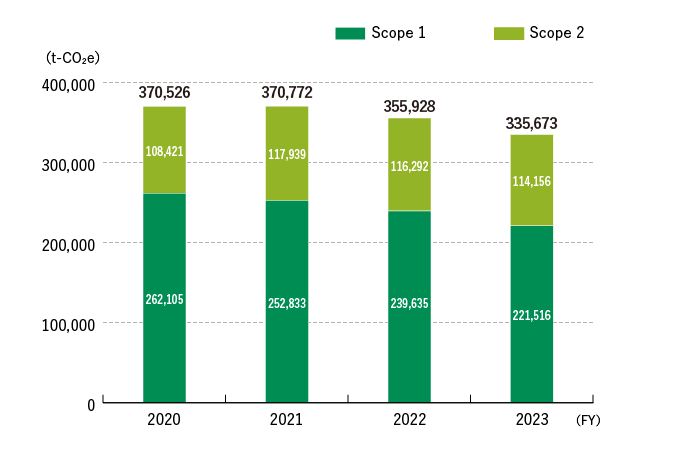
(Reference)
The Sumitomo Forestry Group's greenhouse gas emissions are calculated by using heat conversion factor and carbon dioxide emission factors stipulated in the Act on Promotion of Global Warming Countermeasures, and the heat conversion factor measured at the biomass power generation plant. Since the heat conversion factors and greenhouse gas emission factors stipulated in the Act on Promotion of Global Warming Countermeasures were updated in December 2023, we also disclose the emissions calculated using the pre-update factors for reference. Furthermore, some equity-method affiliates were excluded from the scope of calculations in accordance with the update, thus the data before the update includes some equity-method affiliates.
Scope 1 and Scope 2 CO2 Emission Trends
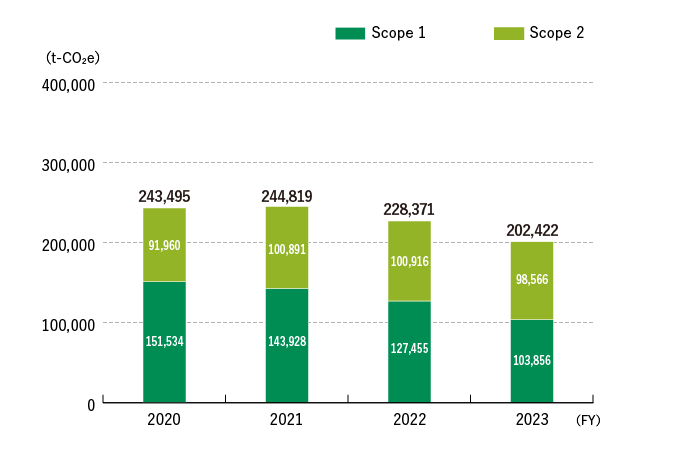
*Including greenhouse gas emission factors stipulated under the Act on Promotion of Global Warming Countermeasures prior to its revision, as well as equity-method affiliates such as PT.Rimba Partikel Indonesia (RPI)
Scope 1 and 2 Breakdown by Business
(FY2024)
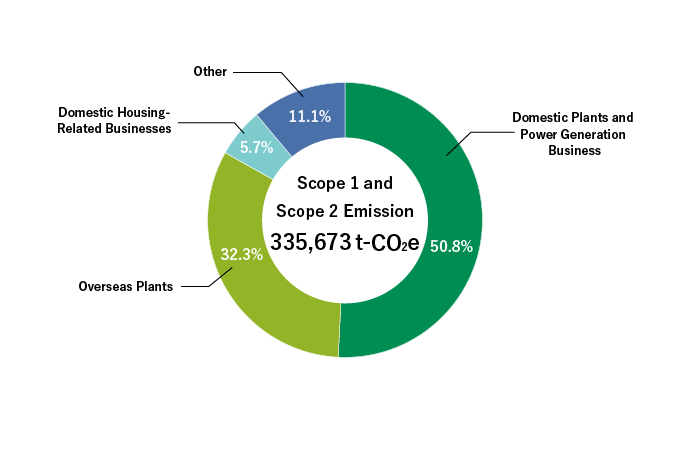
Scope 3 Emissions by Category
(FY2024)
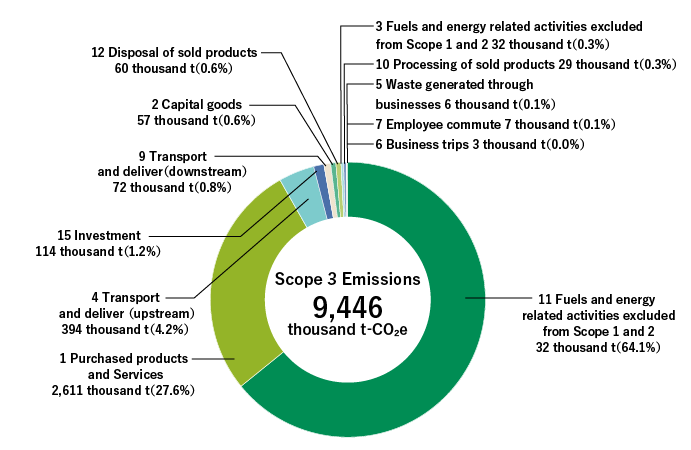
Scope 3 Emissions by Category (three years)*1
(thousand t-CO2e)
| Category | Boundary of Emissions included in the Category | FY2022 | FY2023 | FY2024 |
|---|---|---|---|---|
| 1 Purchased products and services*1 | Emission from upstream of products and services purchased by Sumitomo Forestry | 2,780 | 2,727 | 2,889 |
| 2 Capital goods | Emissions from upstream of purchased equipment | 47 | 57 | 69 |
| 3 Fuels and energy related activities excluded from Scope 1 and 2 | Emissions from the upstream of purchased fuels, electricity, heat capacity, and water | 32 | 30 | 30 |
| 4 Transport and deliver (upstream) | Emissions from Sumitomo Forestry distribution from suppliers of purchased products and services in (1) and emissions due to logistics services other than (1) for costs incurred by Sumitomo Forestry | 439 | 393 | 447 |
| 5 Waste generated through businesses | Emissions from waste treatment and its transport | 7 | 6 | 6 |
| 6 Business trips | Emissions related to business trips of employees such as use of public transportation and accommodation | 2 | 3 | 4 |
| 7 Employee commute | Emissions from employee commuting | 6 | 7 | 8 |
| 8 Leased property (Upstream) | (Emissions from use of upstream leased property such as office building, heavy machinery, vehicles, and facilities are included in Scope 1 or 2) | - | - | - |
| 9 Transport and deliver (downstream) | Emissions during transport of products sold | 81 | 80 | 88 |
| 10 Processing of sold products | Emissions from processing of logs into plywood as well asof sold precut processing of sold lumber | 42 | 83 | 81 |
| 11 Use of sold products | Emissions during use of detached houses sold | 6,524 | 6,695 | 6,898*2 |
| 12 Disposal of sold products | Emissions from demolition and disposal of detached houses sold by the Company | 59 | 65 | 63 |
| 13 Leased property (downstream) | (Tenants must belong to the Group and the figures are included in Scope 1 and 2 of the Group) | - | 8 | 8 |
| 14 Franchised | (excluded) | - | - | - |
| 15 Investment | Emissions from the investees (based on the Company's proportional share) | 120 | 114 | 144 |
| Total | 10,139 | 10,269 | 10,735 | |
*1From fiscal 2022, the scope of the calculations was expanded. The greenhouse gas emission factor for biomass combustion was changed to the factor specified in the Act on Promotion of Global Warming Countermeasures, which was updated in December 2023. In addition, equity-method affiliates are excluded from the scope of calculations
*2From fiscal 2024 onward, the calculation includes refrigerant leakage from air conditioning of sold houses
FY2024 Total Greenhouse Gas Emissions Accrued from Corporate Activities
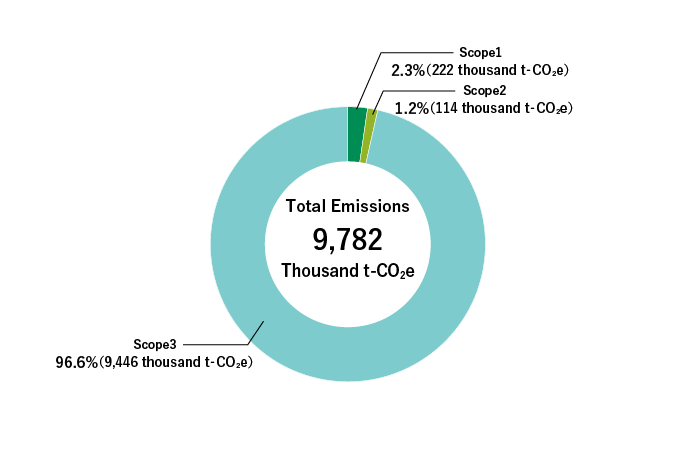
- Click here for related information
Energy Used in Business Activities and the Adoption of Renewable Energy
Energy consumption by the Sumitomo Forestry Group in fiscal 2024 was 2,768,650 MWh*, the same level as the previous year. In the power generation business, energy consumption associated with the power generation process is excluded from reduction targets. However, efforts are being made to reduce energy consumption in the other businesses through various energy-saving activities. In addition, the adoption rate of renewable energy in fiscal 2024 is 81.7%.
*Energy input in the Balance of Input & Output is calculated in TJ based on the Ministry of the Environment's "Environmental Reporting Guidelines." Both calculated from the same energy use
Energy Consumption and Renewable Energy Usage Trends

- Click here for related information
Reducing Greenhouse Gas Emissions
All business sites of Group companies in Japan disposed of standard settings for gasoline vehicles in fiscal 2019 and have been advancing the introduction of fuel-efficient vehicles. To date, 396 of the 413 company-owned vehicles introduced during 2024 were fuel-efficient vehicles. The introduction rate of fuel-efficient vehicles increased by 3.4 percentage points from the previous fiscal year, reaching 95.8%.
Reducing travel distance through direct travel to and from destinations also shortens travel time, which helps curb long working hours. We will raise employee awareness and continue to promote the reduction of greenhouse gas emissions.
Reducing greenhouse gas emissions from transportation
Under the revised Act on the Rational Use of Energy in Japan, consigners*1 are required to reduce per-unit energy consumption by an annual average of 1% or more in the medium to long term in relation to the transportation of goods. Sumitomo Forestry, Sumitomo Forestry Crest and Sumitomo Forestry Wood Products fall under the category of "specified consigner" (annual freight transportation volume is 30 million ton-km*2 or more), obligating them to submit reports to the Japanese Government.
Sumitomo Forestry therefore sets a target each fiscal year to reduce per-unit energy consumption*3 in transportation by 1% or more compared to the previous year. Sumitomo Forestry Crest and Sumitomo Forestry Wood Products also set targets to reduce per-unit energy consumption compared to the previous year.
In fiscal 2023, Sumitomo Forestry's per-unit energy consumption was 104.5% compared to the previous year and Sumitomo Forestry Crest's was 80.5%. Sumitomo Forestry Wood Products' was 84.2%, all falling short of their targets. The increase at Sumitomo Forestry was due to a decline in the loading rates of several contractors that had previously handled large volumes with high transport efficiency as well as an increase in contractors that shifted from short-distance to long-distance transportation.
In the future, we will work with transporters to further reduce CO2 emissions by improving loading efficiency, modal shift from trucks to rail and ship transport, and waste transport using return trips for building material deliveries.
On the other hand, at Sumitomo Forestry Forest Service, per-unit energy consumption decreased due to a reduction in transport volume caused by a change in the type of transactions. Sumitomo Forestry Crest also saw a decrease, and will continue efforts to reduce the number of trips by improving loading efficiency.
*1Cosigners as defined in the Act on the Rational Use of Energy in Japan is someone who transports cargo to carriers for our businesses
*2Freight transportation volume (ton-kilometers) = freight weight (tons) × distance travelled (km)
*3Sumitomo Forestry and Sumitomo Forestry Wood Products measure energy consumption per unit of volume handled. Sumitomo Forestry Crest measures energy consumption per unit of net sales
Energy consumption for transportation (FY2023)*
| Energy Use (Crude Oil Equivalent) | CO2 Emissions | Energy Consumption Per Unit | |
|---|---|---|---|
| Sumitomo Forestry | 1,304kL | 3,516t-CO2 | 0.002157kL/m3 (Ratio to Previous FY: 104.5%) |
| Sumitomo Forestry Crest Co., Ltd. | 1,793kL | 4,826t-CO2 | 0.00005847kL/1,000 Yen (Ratio to Previous FY: 80.5%) |
| Sumitomo Forestry Wood Products Co., Ltd. | 1,875kL | 5,045t-CO2 | 0.0007843kL/m3 (Ratio to Previous FY: 84.2%) |
*Calculation period is "fiscal year (April to March)" / April 2023 to March 2024 as specified in Act on the Rational Use of Energy in Japan
Establishment of an Efficient Delivery
Sumitomo Forestry Homes has a system in which materials from multiple manufacturers are gathered at approximately 30 relay centers across Japan and delivered in mixed loads, thereby reducing CO2 emissions during the transportation process.
Home Eco Logistics takes on logistics operations for the Sumitomo Forestry Group with the housing business at the core and also actively puts forward proposals for efficient logistics operations to material manufacturers, housing builders, housing construction companies and building material distributors. There are approximately 110 logistics contractors as of the end of December 2024, excluding the Sumitomo Forestry Group. We also provide logistics support through a delivery matching system that directly connects shippers with drivers and carriers via the web, improving the efficiency of delivery request operations and providing emergency delivery services. As of the end of December 2024, approximately 80 companies (approximately 230 on a location basis) are using this service.
In the future, we will actively strive in cooperative distribution through multiple companies because of insufficient shipment capacity forecast due to a decrease in the amount of new housing construction.
Modal Shift in Tree Transportation
In March 2022, Sumitomo Forestry Landscaping, in collaboration with Nippon Freight Railway Company, Kawasaki Kinkai Kisen Kaisha, Ltd. and Nippon Express Co., Ltd. started full-scale operation of "Green Delivery Service." "Green Delivery Service" is a tree delivery service that aims for low-carbon by modal shifting from trucks to railroads and ships for trunk line transportation. In fiscal 2024, we transported trees from southern Kyushu to the Tokyo metropolitan area by train on one occasion and 115 times by ship (including several routes and shipping companies). We will continue to promote modal shifts to reduce CO2 emissions and as a countermeasure against logistics disruption risks caused by the shortage of delivery drivers.
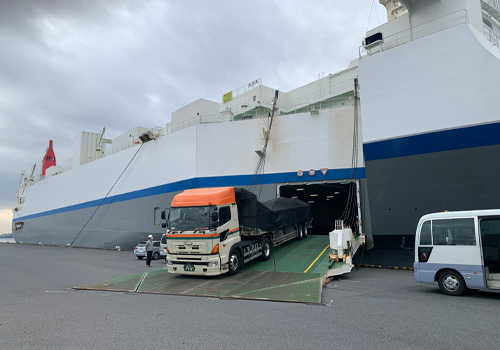
"Green Delivery Service®" transportation by ship
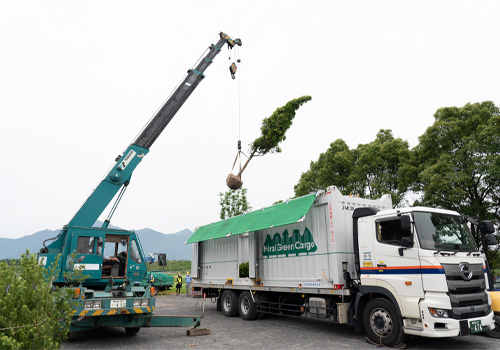
Scene of tree delivery

"Green Delivery Service®" transportation by railway
Climate Change-Related Risks and Strategies
The Sumitomo Forestry Group is aware of the risk to our business activities from environmental changes such as climate change or biodiversity loss and works to gather related information, analyze this information as necessary as a way to evaluate business risks.
We also determined specific measures as evaluation metrics in each department for risk with the potential to arise in daily operations and report on the progress of those measures to the Risk Management Committee each quarter while the Sustainability Committee formulates measures for risk with the potential to arise in the medium to long term. Risks with the potential to high impact business are reported to the Board of Directors to discuss their countermeasures.
- Click here for related information
Risks Related to Energy Supply Shortages and Emission Reduction Mandates
In June 2022, Japan's power crisis has become apparent, as tight supply-demand warning was issued for four consecutive days in the service area of Tokyo Electric Power Company. Due to factors such as extreme weather events, there is a risk that disruptions of power transmissions may cause the Sumitomo Forestry Group's exhibition halls and factories to cease operations.
Furthermore, as the reduction of greenhouse gases advances globally, there is the possibility that reduction obligations will be imposed upon businesses in countries where the Sumitomo Forestry Group has bases. If Group companies with bases in these countries are unable to meet reduction obligations, they will be required to purchase emission credits, creating the risk of increased business costs.
In regard to Japan, carbon pricing has also been implemented due to the Tax for Climate Change Mitigation measures enforced in October 2012. In addition, an emissions trading system is scheduled to be implemented from fiscal 2026. Achieving targets outlined in the Paris Agreement could result in changes such as higher taxes and new levies and emissions trading, which could influence business activities and costs.
The Sumitomo Forestry Group is not expected to fall under the category of "companies with annual CO2 emissions of 100,000 tons or more," which will be subject to the emissions trading system scheduled to start in Japan in fiscal 2026. However, as a measure against this, each company and division within the Sumitomo Forestry Group has set greenhouse gas reduction targets and is advancing reductions in accordance with the numerical targets established annually. We are also promoting reductions in electricity consumption by installing solar power generation on the roofs of exhibition halls and factories. We are also considering introduction of internal carbon pricing to promote reduction in greenhouse gas emissions and continue sustainable growth.
- Click here for related information
Risk Related to the Deterioration of the Corporate Image
Any failure in addressing climate change-related risks may be detrimental to the corporate image and directly affect sales and other performance indicators.
Through its Risk Management Committee and ESG Promotion Committee, the Sumitomo Forestry Group comprehensively analyzes and addresses environmental, social, and governance risks from short-term to medium- and long-term perspectives. We also engage in dialogues with our stakeholders, including investors, as necessary and solicit feedback from third parties on the Sumitomo Forestry Group.
- Click here for related information
- Home
- Sustainability
- Environment
- Responding to Climate Change
- Greenhouse Gas Emissions from Business Activities

